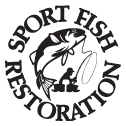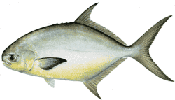CONTACT US:
Florida Fish and Wildlife
Conservation Commission
Fish and Wildlife
Research Institute
100 Eighth Avenue SE
St. Petersburg, Florida 33701
727-896-8626
|
|
|
City of Jacksonville
Parks and Recreation
214 N. Hogan Street
Third Floor
Jacksonville, Florida
32202
904-630-2489
|
|
|


|
|
This project was funded in part by a grant awarded by the and .
|

|
|
Additional funding for this project was obtained through the .
|
|
|
 |
Fish images, except striped bass, © Diane Rome Peebles. Striped bass image © Duane Raver, Jr. Illustrations provided for viewing purposes only.
Below is a small list of the popular sport fish caught in the waters of Nassau and Duval Counties.
|
 |
Striped Bass: found primarily in the St. Johns River and its tributaries, and a few panhandle rivers; does not tolerate water temperatures over 75° F for long periods of time. |
 |
Bluefish: Travels in large schools, following schools of baitfish; cannibalistic; all members of a given school about the same size; spawning occurs offshore in spring and summer. |
 |
Cobia: Both inshore and nearshore inhabiting inlets, bays and among mangroves; frequently seen around buoys, pilings, and wrecks. |
 |
Dolphin (Mahi-mahi): Offshore in warm waters of the Gulf Stream. |
 |
Black Drum: Inshore fish common to bays and lagoons; bottom dweller often found around oyster beds; also offshore. |
 |
Red Drum (Redfish): Inshore near grass beds, oyster bars, and docks pilings; deeper channels during the warmest and coolest months |
 |
Southern Flounder: Inshore within bays near or within grass flats during spring and summer. |
 |
Black Grouper: Offshore species; adults associated with rocky bottoms, reef, and drop-off walls in water over 60 feet deep; young may occur inshore in shallow water |
 |
Gag (Gag Grouper): Adults offshore over rocks and reefs; juveniles occur in seagrass beds inshore |
 |
Red Grouper: Bottom dwelling fish associated with hardbottom; juveniles offshore along with adults greater than six years old; nearshore reefs |
 |
Crevalle Jack (Jack Crevalle): Common to both inshore waters and the open sea. |
 |
Southern Kingfish (Whiting): Shallow Coastal waters; common along beaches. |
 |
King Mackerel (Kingfish): Nearshore and offshore; occasionally taken from piers running into deep water. |
 |
Spanish Mackerel: Inshore, nearshore, and offshore over grass beds and reefs |
 |
Florida Pompano: Inshore and nearshore waters, especially along sandy beaches, along oyster bars, and over grass beds, often in turbid water; may be found in water as deep as 130 feet. |
 |
Spotted Seatrout (Speckled Seatrout): Inshore over grass beds, sand, and sandy/mud bottoms; deeper water during warmest and coolest months. |
 |
Sheepshead: Inshore around oyster bars, seawalls, and in tidal creeks; moves nearshore in late winter and early spring for spawning, gathering over rocks, artificial reefs, and around navigation markers. |
 |
Gray (Mangrove) Snapper: Juveniles inshore in tidal creeks, mangroves, and grass beds; adults generally nearshore or offshore on coral or rocky reefs. |
 |
Red Snapper: Juveniles inshore in tidal creeks, mangroves, and grass beds; adults generally nearshore or offshore on coral or rocky reefs. |
 |
Tarpon: Found mostly inshore near bridges, pilings, rock walls, harbors, around structures, and on flats. |
 |
Weakfish: Adults-move inshore north during warm months inhabiting the surf, inlets, bays channels and estuaries; move offshore and south during cold months. Juveniles-inhabits estuaries which serve as nurseries. |
Back to Top
|
If you have any questions, comments, or suggestions about this Web site, please e-mail us at Boating_Guides@MyFWC.com.
Would you like to receive notices of changes to this Web site and the Boating and Angling Guide to Nassau and Duval Counties? If so, please e-mail us and include SUBSCRIBE-DUVAL in the subject line.
|
|



